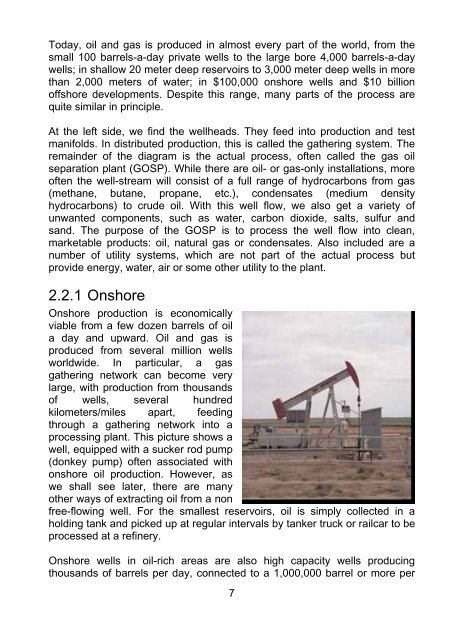Oil and gas production handbook An introduction to oil ... - ABB Group
Oil and gas production handbook An introduction to oil ... - ABB Group
Oil and gas production handbook An introduction to oil ... - ABB Group
You also want an ePaper? Increase the reach of your titles
YUMPU automatically turns print PDFs into web optimized ePapers that Google loves.
Today, <strong>oil</strong> <strong>and</strong> <strong>gas</strong> is produced in almost every part of the world, from the<br />
small 100 barrels-a-day private wells <strong>to</strong> the large bore 4,000 barrels-a-day<br />
wells; in shallow 20 meter deep reservoirs <strong>to</strong> 3,000 meter deep wells in more<br />
than 2,000 meters of water; in $100,000 onshore wells <strong>and</strong> $10 billion<br />
offshore developments. Despite this range, many parts of the process are<br />
quite similar in principle.<br />
At the left side, we find the wellheads. They feed in<strong>to</strong> <strong>production</strong> <strong>and</strong> test<br />
manifolds. In distributed <strong>production</strong>, this is called the gathering system. The<br />
remainder of the diagram is the actual process, often called the <strong>gas</strong> <strong>oil</strong><br />
separation plant (GOSP). While there are <strong>oil</strong>- or <strong>gas</strong>-only installations, more<br />
often the well-stream will consist of a full range of hydrocarbons from <strong>gas</strong><br />
(methane, butane, propane, etc.), condensates (medium density<br />
hydrocarbons) <strong>to</strong> crude <strong>oil</strong>. With this well flow, we also get a variety of<br />
unwanted components, such as water, carbon dioxide, salts, sulfur <strong>and</strong><br />
s<strong>and</strong>. The purpose of the GOSP is <strong>to</strong> process the well flow in<strong>to</strong> clean,<br />
marketable products: <strong>oil</strong>, natural <strong>gas</strong> or condensates. Also included are a<br />
number of utility systems, which are not part of the actual process but<br />
provide energy, water, air or some other utility <strong>to</strong> the plant.<br />
2.2.1 Onshore<br />
Onshore <strong>production</strong> is economically<br />
viable from a few dozen barrels of <strong>oil</strong><br />
a day <strong>and</strong> upward. <strong>Oil</strong> <strong>and</strong> <strong>gas</strong> is<br />
produced from several million wells<br />
worldwide. In particular, a <strong>gas</strong><br />
gathering network can become very<br />
large, with <strong>production</strong> from thous<strong>and</strong>s<br />
of wells, several hundred<br />
kilometers/miles apart, feeding<br />
through a gathering network in<strong>to</strong> a<br />
processing plant. This picture shows a<br />
well, equipped with a sucker rod pump<br />
(donkey pump) often associated with<br />
onshore <strong>oil</strong> <strong>production</strong>. However, as<br />
we shall see later, there are many<br />
other ways of extracting <strong>oil</strong> from a non<br />
free-flowing well. For the smallest reservoirs, <strong>oil</strong> is simply collected in a<br />
holding tank <strong>and</strong> picked up at regular intervals by tanker truck or railcar <strong>to</strong> be<br />
processed at a refinery.<br />
Onshore wells in <strong>oil</strong>-rich areas are also high capacity wells producing<br />
thous<strong>and</strong>s of barrels per day, connected <strong>to</strong> a 1,000,000 barrel or more per<br />
7

















